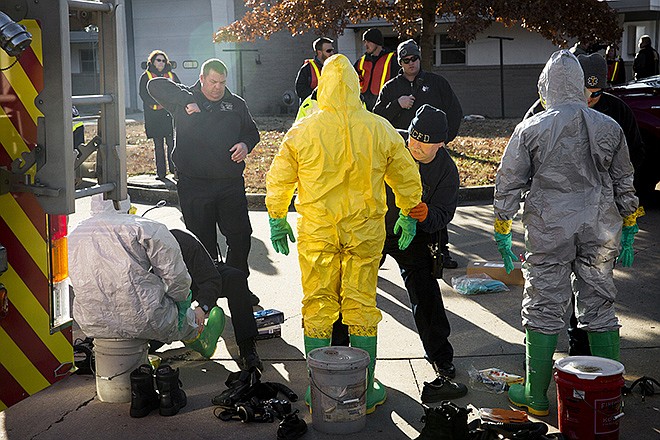Emergency medical technicians suited up in hazardous material (hazmat) handling gear, while firefighters and police officers cordoned off Jefferson City Fire Station No. 3 for a drill on Wednesday morning.
The drill was to rehearse protocol for handling someone with an infectious disease. Agencies such as paramedics, firefighters, police, dispatchers, hospital workers and officials from the Cole County Health Department came together to participate in this exercise. They have been planning the event since October.
"We have been trying to have a cooperative and, I would say, cohesive effort to coordinate emergency responses to infectious diseases of all types," Fire Chief Matt Schofield said. "We have seen these types of incidents before ... after 9/11 with suspicious substances, and we have seen bird flu and swine flu and everything else.
"We don't know what is in store for the future, but we think this type of coordinated response is what is going to be required for us to be prepared."
The drill started around 9 a.m., when dispatchers sent the information to first responders, who then came to the station and suited up in hazmat gear. After retrieving the "infected" individual, they brought him to Capital Region Medical Center. Schofield said it took the crew about 45 minutes to don the gear. He said good communication was one of the most valuable assets in such a situation.
"It is highly unlikely that this would happen in Cole County," said Kristi Campbell, director of the Cole County Health Department. "The Cole County Health Department would be notified by the Missouri Department of Health and Senior Services (DHSS) if someone was traveling back from an infected country. So we would be able to monitor that person, and as soon as they started to show any symptoms ... we would know and we would be able to get them tested before it came to the phase were they were vomiting and needed immediate ambulance attention."
The Division of Global Migration and Quarantine of the Centers for Disease Control (CDC) monitors travelers and communicates with state health departments about activities from infected areas. This division would inform the DHSS if someone was at risk of transferring an infectious disease, Campbell said.
The patient was taken to the hospital, where staff took over the drill and began treating the patient and communicating with the CDC to receive permission to draw blood for testing in a state lab to identify any disease.
"It was great, I mean just to know that people are considering what the steps we take if something does happen," said Stallone Watson, volunteer infectious disease victim.
Watson organized the Lincoln University International Student Association to help people in West Africa by raising awareness and acquiring face masks, gloves and children's clothes for orphans who have lost parents to Ebola.

